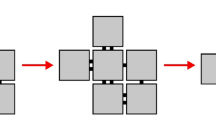Abstract
In this paper, we prove that in the abstract Tile Assembly Model (aTAM), an accretion-based model which only allows for a single tile to attach to a growing assembly at each step, there are no tile assembly systems capable of self-assembling the discrete self-similar fractals known as the “H” and “U” fractals. We then show that in a related model which allows for hierarchical self-assembly, the 2-Handed Assembly Model (2HAM), there does exist a tile assembly system which self-assembles the “U” fractal and conjecture that the same holds for the “H” fractal. This is the first example of discrete self similar fractals which self-assemble in the 2HAM but not in the aTAM, providing a direct comparison of the models and greater understanding of the power of hierarchical assembly.


























Similar content being viewed by others
Notes
Note that we use the standard DSSF definition, restricted to the first quadrant of \(\mathbb {Z} \times \mathbb {Z}\). Our impossibility result proofs could be trivially modified to hold for alternate definitions which allow for DSSFs to occupy any set of quadrants.
References
Cannon S, Demaine ED, Demaine ML, Eisenstat S, Patitz MJ, Schweller RT, Summers SM, Winslow A (2013) Two hands are better than one (up to constant factors): self-assembly in the 2HAM vs. aTAM. In: Portier N, Wilke T (eds) STACS, vol. 20 of LIPIcs, pp 172–184. Schloss Dagstuhl—Leibniz-Zentrum fuer Informatik
Chalk CT, Fernandez DA, Huerta A, Maldonado MA, Schweller RT, Sweet L (2016) Strict self-assembly of fractals using multiple hands. Algorithmica 76(1):95–224
Chen H-L, Doty D (2012) Parallelism and time in hierarchical self-assembly. In: SODA 2012: proceedings of the 23rd annual ACM-SIAM symposium on discrete algorithms. SIAM, pp 1163–1182
Cheng Q, Aggarwal G, Goldwasser MH, Kao M-Y, Schweller RT, de Espanés PM (2005) Complexities for generalized models of self-assembly. SIAM J Comput 34:1493–1515
Fujibayashi K, Hariadi R, Park SH, Winfree E, Murata S (2007) Toward reliable algorithmic self-assembly of DNA tiles: a fixed-width cellular automaton pattern. Nano Lett 8(7):1791–1797
Furcy D, Summers SM (2017) Scaled pier fractals do not strictly self-assemble. Nat Comput 16(2):317–338
Hendricks J, Olsen M, Patitz MJ, Rogers TA, Thomas H (2016) Hierarchical self-assembly of fractals with signal-passing tiles (extended abstract). In: Proceedings of the 22nd international conference on DNA computing and molecular programming (DNA 22). Ludwig-Maximilians-Universität, Munich, Germany, pp 82–97
Hendricks J, Opseth J (2017) Self-assembly of 4-sided fractals in the two-handed tile assembly model. In: Proceedings of the 16th annual conference on unconventional computation and natural computation (UCNC 2017), Fayetteville, Arkansas, USA, pp 113–128
Jonoska N, Karpenko D (2014a) Active tile self-assembly, part 1: universality at temperature 1. Int J Found Comput Sci 25(02):141–163
Jonoska N, Karpenko D (2014b) Active tile self-assembly, part 2: self-similar structures and structural recursion. Int J Found Comput Sci 25(02):165–194
Kautz S, Shutters B (2013) Self-assembling rulers for approximating generalized Sierpinski carpets. Algorithmica 67(2):207–233
Kautz SM, Lathrop JI (2009) Self-assembly of the Sierpinski carpet and related fractals. In: Proceedings of The fifteenth international meeting on DNA computing and molecular programming, Fayetteville, Arkansas, USA, pp 78–87
Lathrop JI, Lutz JH, Summers SM (2009) Strict self-assembly of discrete Sierpinski triangles. Theor Comput Sci 410:384–405
Luhrs C (2008) Polyomino-safe DNA self-assembly via block replacement. In: Goel A, Simmel FC, Sosík P, (eds) DNA 14, vol 5347 of lecture notes in computer science. Springer, pp 112–126
Lutz JH, Shutters B (2012) Approximate self-assembly of the Sierpinski triangle. Theory Comput Syst 51(3):372–400
Patitz MJ, Rogers TA, Schweller RT, Summers SM, Winslow A (2016) Resiliency to multiple nucleation in temperature-1 self-assembly. In: Proceedings of the 22nd international conference on DNA computing and molecular programming (DNA 22). Ludwig-Maximilians-Universität, Munich, Germany, pp 98–113
Patitz MJ, Summers SM (2010) Self-assembly of discrete self-similar fractals. Nat Comput 1:135–172
Rothemund PW, Papadakis N, Winfree E (2004) Algorithmic self-assembly of DNA Sierpinski triangles. PLoS Biol 2(12):2041–2053
Winfree E (1998) Algorithmic self-assembly of DNA. Ph.D. thesis, California Institute of Technology
Author information
Authors and Affiliations
Corresponding author
Additional information
Publisher's Note
Springer Nature remains neutral with regard to jurisdictional claims in published maps and institutional affiliations.
M. J. Patitz’s research was supported in part by National Science Foundation Grants CCF-1422152 and CAREER-1553166.
Rights and permissions
About this article
Cite this article
Hendricks, J., Opseth, J., Patitz, M.J. et al. Hierarchical growth is necessary and (sometimes) sufficient to self-assemble discrete self-similar fractals. Nat Comput 19, 357–374 (2020). https://doi.org/10.1007/s11047-019-09777-z
Published:
Issue Date:
DOI: https://doi.org/10.1007/s11047-019-09777-z




